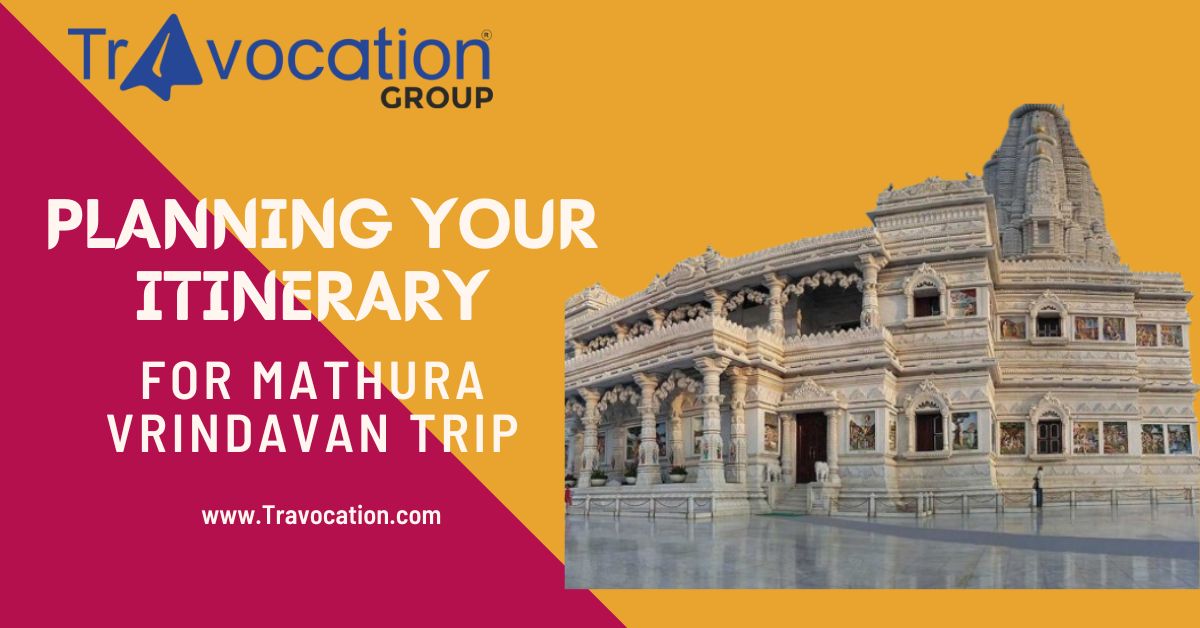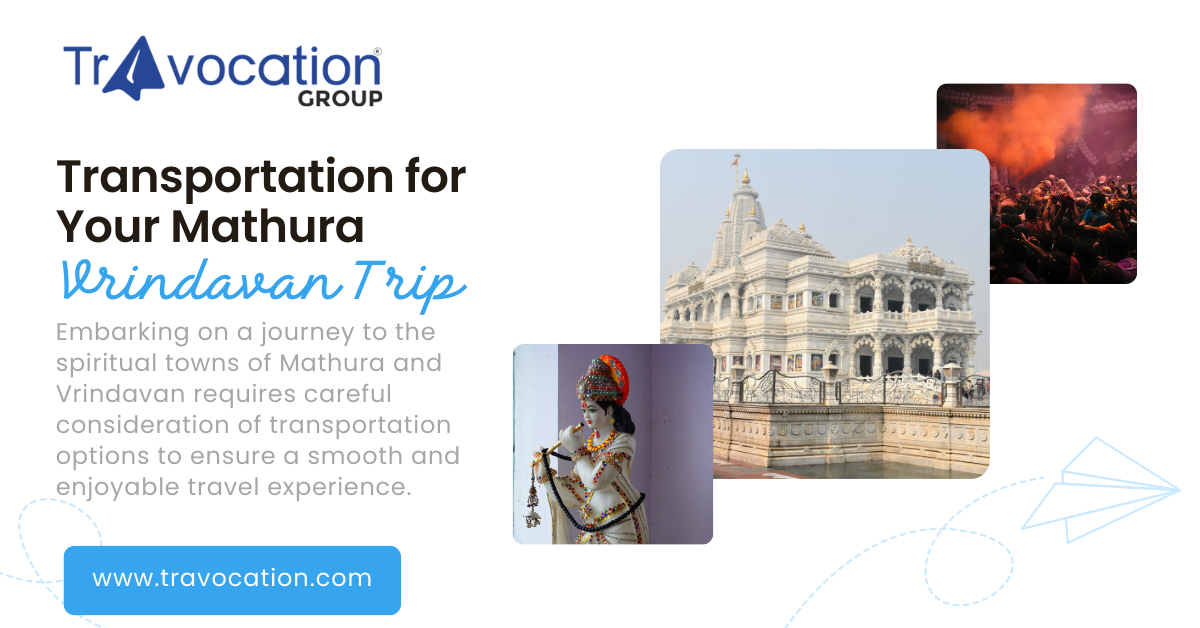Are you yearning for a soul-soothing journey through the sacred lands of Mathura Vrindavan? Look no further! Planning your trip to these spiritual havens requires careful consideration and thoughtful decisions. Let’s dive into a comprehensive guide to help you orchestrate a memorable Mathura Vrindavan expedition.
Mathura Vrindavan Trip, nestled in the heart of Uttar Pradesh, India, are synonymous with the divine love story of Krishna and Radha. These holy towns hold immense significance for devotees worldwide, attracting pilgrims and tourists seeking cultural immersion and spiritual connection. Planning a trip to Mathura Vrindavan, the land of Lord Krishna’s divine lila (play), can be a truly enriching experience. Here’s a guide to help you plan your trip:
Introduction
Brief on Mathura and Vrindavan
Nestled on the banks of the Yamuna River, Mathura and Vrindavan are revered as the birthplace of Lord Krishna. These towns, brimming with spirituality and history, attract pilgrims, historians, and curious travelers alike.
The Allure of a Trip to These Spiritual Towns
Embarking on a journey to Mathura and Vrindavan isn’t just a vacation; it’s a pilgrimage of the heart. The vibrant culture, ancient temples, and the ethereal aura promise an experience like no other.
Planning Your Itinerary For Mathura Vrindavan Trip

Deciding on the Duration of Your Trip
The first step in planning your Mathura Vrindavan Trip is determining how much time you can devote to this spiritual escapade. A weekend retreat or an extended stay? Tailor your itinerary to match your schedule.
Identifying Key Attractions
Temples in Mathura
Mathura boasts a myriad of temples, each narrating a unique story. Don’t miss the iconic Krishna Janmabhoomi and Dwarkadhish Temple, showcasing architectural marvels and spiritual significance.
Spiritual Spots in Vrindavan
Vrindavan, adorned with countless ashrams and ghats, offers a serene ambiance. Plan visits to the Radha Raman Temple and Banke Bihari Temple for an immersion in divine tranquility.
Transportation for Your Mathura Vrindavan Trip

Embarking on a journey to the spiritual towns of Mathura and Vrindavan requires careful consideration of transportation options to ensure a smooth and enjoyable travel experience. Here’s a guide to navigating your way to these sacred destinations:
Choosing the Right Mode of Transport
1. By Road:
- Pros: A road trip offers scenic views, flexibility in stops, and a chance to explore the countryside.
- Cons: Travel time may vary depending on traffic conditions, and road conditions might be challenging in some areas.
2. By Train:
- Pros: Trains provide a comfortable and efficient mode of transport with various classes to suit different budgets.
- Cons: Advance booking is advisable, and train schedules need to be checked to plan your journey effectively.
3. By Air:
- Pros: The fastest mode of transport, particularly for long-distance travelers.
- Cons: Limited airports in the vicinity may require additional ground transportation.
Navigating Within Mathura and Vrindavan
1. Auto-Rickshaws:
- Pros: Widely available, affordable, and a convenient way to navigate through narrow lanes.
- Cons: Negotiate fares beforehand and ensure the driver uses the meter.
2. Cycle Rickshaws:
- Pros: Eco-friendly and suitable for short distances within town.
- Cons: Agree on fares before the journey, and be prepared for slower travel.
3. Local Buses:
- Pros: Cost-effective and connect various parts of Mathura and Vrindavan.
- Cons: Schedules may not be as frequent, and buses might be crowded.
4. Taxi Services:
- Pros: Offers a more private and comfortable travel experience.
- Cons: Ensure the use of licensed and reliable taxi services to avoid scams.
5. Renting a Vehicle:
- Pros: Provides flexibility in exploring nearby attractions at your own pace.
- Cons: Familiarize yourself with local traffic rules and road conditions before driving.
6. Walking:
- Pros: Many attractions are within walking distance, allowing a leisurely exploration.
- Cons: Check the weather and plan accordingly, especially during extreme temperatures.
Tips for Efficient Transportation
- Plan Ahead:
- Research and choose the transportation mode that aligns with your preferences and schedule.
- Book in Advance:
- For trains, flights, or accommodations, booking in advance ensures availability and often provides cost savings.
- Check Local Transport Schedules:
- Understand the operating hours and schedules of local buses and other transportation options.
- Be Mindful of Peak Hours:
- If traveling by road, plan your journey to avoid peak traffic hours for a smoother ride.
- Budget for Transportation:
- Allocate a portion of your budget specifically for transportation expenses to avoid overspending.
- Use Local Apps:
- Utilize local transportation apps for real-time information on schedules, routes, and fares.
- Stay Informed About Strikes or Festivals:
- Be aware of any potential disruptions due to strikes or local festivals that might affect transportation services.
- Stay Safe:
- Prioritize safety by choosing reliable modes of transport and following local guidelines.
Accommodations for Your Mathura Vrindavan Trip

Choosing the right accommodations is a crucial aspect of planning your journey to the spiritual towns of Mathura and Vrindavan. Whether you seek the comfort of modern amenities or the serene ambiance of spiritual retreats, here’s a guide to help you find the perfect place to stay:
Options for Staying in Mathura
1. Hotels:
- Pros: Mathura offers a range of hotels catering to various budgets, providing comfort and convenience.
- Cons: Prices may vary, and booking in advance is advisable, especially during peak seasons.
2. Guesthouses:
- Pros: Budget-friendly accommodations with a homely atmosphere, often run by local families.
- Cons: Facilities may be basic, so check reviews to ensure a comfortable stay.
3. Resorts:
- Pros: If you seek a more luxurious experience, resorts in Mathura offer premium amenities and serene surroundings.
- Cons: Higher costs compared to other accommodation options.
4. Ashrams:
- Pros: Immerse yourself in the spiritual atmosphere by staying in ashrams, which often offer simple yet peaceful accommodations.
- Cons: Basic facilities, and adherence to ashram rules is required.
Accommodation Choices in Vrindavan
1. Ashrams and Dharamshalas:
- Pros: Vrindavan is known for its spiritual retreats, providing a serene environment for contemplation and prayer.
- Cons: Basic amenities, communal living, and adherence to ashram rules.
2. Guesthouses and Budget Hotels:
- Pros: Numerous budget-friendly options catering to pilgrims and travelers, offering a comfortable stay.
- Cons: Limited amenities compared to larger hotels.
3. Heritage Havelis:
- Pros: Experience the charm of Vrindavan by staying in heritage havelis, offering a blend of tradition and comfort.
- Cons: Availability may be limited, and prices can be higher.
4. Homestays:
- Pros: Connect with locals by opting for homestays, providing an authentic cultural experience.
- Cons: Limited in number, and facilities may vary.
Tips for Choosing Accommodations
- Research Thoroughly:
- Read reviews on various platforms to ensure the accommodation meets your expectations.
- Consider Proximity to Attractions:
- Choose a place to stay that is conveniently located near the main attractions you plan to visit.
- Check Amenities:
- Depending on your preferences, verify if the accommodation offers the amenities you desire, such as Wi-Fi, air conditioning, or complimentary breakfast.
- Budget Wisely:
- Allocate a reasonable portion of your budget to accommodations, balancing comfort with cost.
- Book in Advance:
- Especially during peak seasons, securing your accommodation in advance ensures availability.
- Cultural Sensitivity:
- Respect local customs and rules, especially when staying in ashrams or heritage properties.
- Safety Considerations:
- Prioritize safety by choosing reputable accommodations and following any security guidelines provided.
- Connect with Locals:
- Consider accommodations that allow interactions with locals, providing insights into the culture and traditions of Mathura and Vrindavan.
Cultural and Festive Calendar: Enhancing Your Mathura Vrindavan Experience

Planning your trip to the spiritual towns of Mathura and Vrindavan? Delve into the cultural and festive calendar to align your visit with vibrant celebrations, immersing yourself in the rich tapestry of traditions.
Aligning Your Visit with Local Festivals
1. Holi:
- Date: Typically in March
- Experience: Witness the spectacular festival of colors. Mathura, known as the birthplace of Lord Krishna, celebrates Holi with unmatched enthusiasm. Join locals in the streets, exchanging colorful powders and enjoying lively processions.
2. Janmashtami:
- Date: Usually in August
- Experience: Commemorating Lord Krishna’s birth, Janmashtami is a grand celebration in Vrindavan. The temples are adorned, processions fill the streets, and cultural events bring the town to life. Don’t miss the midnight ‘aarti’ at major temples.
Embracing the Cultural Richness of the Region
1. Participate in Temple Rituals:
- Experience: Engage in the daily rituals at iconic temples like Dwarkadhish Temple in Mathura and Banke Bihari Temple in Vrindavan. Attend the mesmerizing ‘aarti’ ceremonies to feel the spiritual essence.
2. Explore Local Markets During Festivals:
- Experience: Markets come alive with the hustle and bustle during festivals. Immerse yourself in the vibrant atmosphere, shop for traditional attire, and indulge in festive treats.
3. Attend Cultural Performances:
- Experience: Many festivals feature cultural performances like traditional music, dance, and dramas. Attend these events to witness the artistic heritage of Mathura and Vrindavan.
4. Participate in Community Events:
- Experience: Join in community events organized during festivals. From religious processions to community meals, these gatherings offer a chance to connect with locals.
5. Visit Decorated Temples:
- Experience: Temples are adorned with lights, flowers, and intricate decorations during festivals. Take a stroll in the evenings to witness the mesmerizing beauty and spiritual ambiance.
6. Engage in Rangoli Making:
- Experience: During festivals like Diwali, locals create intricate rangoli designs outside their homes. Join in this artistic expression, learning from the community and adding your touch to the celebrations.
7. Partake in Traditional Cooking Classes:
- Experience: Explore the culinary heritage by participating in traditional cooking classes. Learn to prepare local dishes, gaining insights into the cultural significance of each recipe.
8. Attend Religious Discourses:
- Experience: Festivals often include religious discourses and lectures. Attend these sessions to deepen your understanding of the spiritual teachings embedded in the culture of Mathura and Vrindavan.
Local Cuisine
Exploring Traditional Dishes
Savor the flavors of the region with local delicacies like Peda, Mathura ke Pede, and the renowned Chhappan Bhog.
Recommendations for Food Enthusiasts
Visit local eateries and street vendors for an authentic culinary journey. Don’t forget to try the iconic “Makhan Mishri” – a sweet treat loved by Lord Krishna.
Dos and Don’ts for Your Mathura Vrindavan Trip
| Dos | Don’ts |
|---|---|
| Respect Local Customs | Disregard Local Customs |
| Understand Spiritual Significance | Lack Cultural Sensitivity |
| Align Your Visit with Festivals | Miss Festive Opportunities |
| Explore Local Cuisine | Ignore Local Cuisine |
| Capture Memories Responsibly | Disregard Photography Etiquette |
| Engage with Locals | Isolate Yourself |
| Carve Out Moments for Reflection | Rush Through Spiritual Moments |
| Contribute to Local Economy | Neglect Local Businesses |
| Plan Within Budget | Overspend Without Planning |
| Prioritize Safety | Compromise Safety |
Planning a trip to the sacred towns of Mathura and Vrindavan requires a thoughtful approach to ensure a harmonious and enriching experience. Here are the Dos and Don’ts to guide you through your spiritual journey:
Dos:
- Respect Local Customs:
- Dress modestly when visiting temples and other sacred sites.
- Greet locals with respect, embracing the cultural norms.
- Understand Spiritual Significance:
- Educate yourself about the historical and spiritual importance of each place you visit.
- Engage with rituals respectfully, seeking to understand their significance.
- Align Your Visit with Festivals:
- Plan your trip during local festivals to immerse yourself in the vibrant cultural celebrations.
- Participate in festivities with an open heart, respecting traditions.
- Explore Local Cuisine:
- Indulge in the traditional dishes of Mathura and Vrindavan.
- Support local eateries and street vendors to experience authentic flavors.
- Capture Memories Responsibly:
- Take photographs but do so respectfully, especially in sacred spaces.
- Seek permission when photographing locals, ensuring their comfort.
- Engage with Locals:
- Strike up conversations with residents to learn about their daily lives.
- Attend community events or workshops to build cultural connections.
- Carve Out Moments for Reflection:
- Find quiet corners for personal contemplation amidst the spiritual abundance.
- Utilize the serene atmosphere for self-reflection, meditation, or prayer.
- Contribute to Local Economy:
- Support local artisans by purchasing souvenirs from street markets.
- Choose accommodations and services that benefit the community.
- Plan Within Budget:
- Estimate your expenses and plan activities that align with your budget.
- Discover cost-effective experiences to make the most of your trip.
- Prioritize Safety:
- Stay vigilant and adhere to local guidelines for a secure travel experience.
- Keep valuables secure and be aware of emergency procedures.
Don’ts:
- Disregard Local Customs:
- Avoid disrespectful behavior, such as loud conversations or inappropriate attire in religious spaces.
- Refrain from disrupting local customs or rituals.
- Lack Cultural Sensitivity:
- Steer clear of insensitive remarks or actions that may offend local sentiments.
- Avoid intruding on private ceremonies or events without permission.
- Miss Festive Opportunities:
- Don’t overlook the chance to experience local festivals if your schedule allows.
- Avoid dismissing cultural events, as they add depth to your travel experience.
- Ignore Local Cuisine:
- Don’t stick to familiar foods; embrace the local cuisine for a richer experience.
- Refrain from wasting food, respecting the effort that goes into each dish.
- Disregard Photography Etiquette:
- Don’t take photographs in prohibited areas or of individuals without consent.
- Avoid using flash in sensitive environments, maintaining the sanctity of the space.
- Isolate Yourself:
- Don’t shy away from interactions with locals; engage in conversations and cultural exchanges.
- Avoid staying within your comfort zone; explore the community for a more immersive experience.
- Rush Through Spiritual Moments:
- Don’t hurry through spiritual activities; take the time to absorb the tranquility.
- Avoid loud or disruptive behavior in areas designated for reflection or prayer.
- Neglect Local Businesses:
- Don’t solely rely on international chains; support local businesses for an authentic experience.
- Refrain from bargaining excessively, recognizing the value of local craftsmanship.
- Overspend Without Planning:
- Avoid spontaneous spending that might lead to financial strain.
- Don’t disregard budget-friendly options for accommodations, meals, and activities.
- Compromise Safety:
- Don’t take unnecessary risks or ignore safety guidelines provided by locals.
- Avoid leaving valuables unattended, ensuring a secure travel experience.
Budgeting Tips for Your Mathura Vrindavan Trip
Embarking on a spiritual journey to Mathura and Vrindavan doesn’t have to break the bank. Here are some practical budgeting tips to help you make the most of your pilgrimage without compromising on the experience:
Estimating Expenses for the Trip
- Accommodation:
- Research and book accommodations that align with your budget. Consider a mix of guesthouses, budget hotels, or even ashrams for a more economical stay.
- Transportation:
- Compare prices for different transportation modes. Booking in advance can often result in lower fares, whether you’re opting for trains, buses, or other means.
- Food:
- Explore local eateries and street vendors for authentic yet affordable meals. Don’t miss trying the local specialties without overspending at high-end restaurants.
- Entrance Fees:
- Plan your visits to temples and attractions strategically. Some may have entrance fees, so allocate a portion of your budget for these cultural experiences.
- Miscellaneous Costs:
- Factor in miscellaneous expenses like local transportation within Mathura and Vrindavan, souvenirs, and any unforeseen costs. Having a buffer ensures you’re prepared for unexpected expenses.
Cost-Effective Experiences
- Free Cultural Events:
- Look for free or low-cost cultural events happening during your visit. Festivals, religious discourses, and cultural performances often provide enriching experiences without a hefty price tag.
- Walking Tours:
- Explore the towns on foot. Many attractions are within walking distance, offering a budget-friendly way to absorb the local atmosphere.
- Participate in Community Activities:
- Engage in community events or workshops organized by locals. These experiences often come at a minimal cost and provide insights into the daily life of Mathura and Vrindavan.
- Visit Local Markets:
- Instead of high-end stores, explore local markets for souvenirs and shopping. Supporting local artisans not only contributes to the community but is also often more budget-friendly.
- DIY Photography and Documentation:
- Instead of hiring professional photographers or tour guides, document your journey yourself. Capture the essence of Mathura and Vrindavan through your lens, adding a personal touch to your memories.
Traveling on a Budget
- Off-Peak Travel:
- Consider traveling during off-peak seasons. Not only will you avoid crowds, but accommodation and transportation costs may also be lower.
- Budget-Friendly Accommodations:
- Choose accommodations wisely. While guesthouses and ashrams can be economical, some budget-friendly hotels also offer comfortable stays.
- Local Transportation Options:
- Opt for local transportation like cycle rickshaws or public buses. These are not only affordable but also provide a more authentic experience.
- Pack Essentials:
- Pack wisely, including essentials like a reusable water bottle and snacks. Avoid unnecessary spending on items you can bring from home.
- Plan Your Meals:
- Plan your meals to avoid impulsive spending. Knowing where and what you’ll eat helps you stick to your budget without compromising on culinary experiences.
Best Time to Visit Mathura and Vrindavan
Choosing the right time to visit Mathura and Vrindavan is crucial for a fulfilling and comfortable experience. Consider the following factors to plan your pilgrimage effectively:
Weather Considerations
- Winter (October to February):
- Pros: Pleasant weather, with temperatures ranging from 7°C to 25°C (45°F to 77°F).
- Activities: Ideal for exploring outdoor attractions without the discomfort of extreme heat.
- Festivals: Witness festivals like Diwali and Holi during this period, adding cultural vibrancy to your visit.
- Spring (March to April):
- Pros: Mild temperatures ranging from 15°C to 35°C (59°F to 95°F).
- Activities: Comfortable for outdoor activities and exploration.
- Festivals: Experience the vibrant celebrations of Holi, known for its colorful festivities.
Timing Your Trip for the Optimal Experience
- Avoiding Peak Summers (May to June):
- Cons: High temperatures, often exceeding 40°C (104°F).
- Activities: Extreme heat may limit outdoor exploration, and the scorching sun can be challenging for pilgrimage activities.
- Monsoon Season (July to September):
- Cons: Heavy rainfall and increased humidity.
- Activities: While the rains bring a lush green landscape, it can disrupt outdoor plans and make traveling less convenient.
Tips for Timing Your Visit
- Shoulder Seasons (Spring and Fall):
- Pros: Mild weather and fewer crowds, providing a more intimate experience.
- Activities: Enjoy the best of both worlds – pleasant weather and cultural festivities without the peak tourist rush.
- Festival Considerations:
- Pros: Visiting during festivals enhances the cultural experience.
- Activities: Participate in celebrations, processions, and cultural events to witness the vibrant spirit of Mathura and Vrindavan.
- Plan Around Your Preferences:
- Pros: Tailor your visit based on personal preferences.
- Activities: If you prefer a serene and less crowded experience, opt for off-peak seasons. For lively festivities, plan your trip during major festivals.
- Check Local Events Calendar:
- Pros: Ensure your visit aligns with local events and festivals.
- Activities: Accessing the local events calendar helps you plan your itinerary around cultural celebrations and significant occasions.
- Consider Midweek Travel:
- Pros: Reduced crowds during weekdays.
- Activities: Explore popular sites with more tranquility, allowing for a more contemplative pilgrimage experience.
Photography and Documentation
Capturing Memories Responsibly
Preserve the beauty of your journey through photography. However, be respectful of sacred spaces and seek permission when needed.
Preserving the Essence of Your Journey
Document your experiences through a travel journal or blog. Reflecting on your journey adds a personal touch to the memories you create.
Safety Measures
Ensuring a Secure Travel Experience
Prioritize your safety by being vigilant and adhering to local guidelines. Keep valuables secure and stay informed about emergency procedures.
Health Precautions to Keep in Mind
Carry essential medications, stay hydrated, and be mindful of your health. A healthy traveler enjoys the journey to the fullest.
Souvenir Shopping
Popular Items to Buy
Bring a piece of Mathura Vrindavan with you by shopping for religious artifacts, traditional clothing, and handmade crafts.
Supporting Local Artisans
Contribute to the local economy by purchasing from street markets and small businesses. Your souvenirs become a connection to the artisans’ craftsmanship.
Interacting with Locals
Building Cultural Connections
Engage with the local community. Conversations with residents provide insights into the daily life and spirituality that permeate Mathura and Vrindavan.
Learning from the Community
Attend workshops or discussions to deepen your understanding of the cultural nuances. Locals often share valuable insights that enrich your travel experience.
Reflection and Meditation
Carving Out Moments for Personal Contemplation
In the midst of spiritual abundance, find quiet corners for personal reflection. The tranquility of these towns encourages moments of introspection.
Utilizing the Spiritual Atmosphere for Self-Reflection
Whether through meditation or prayer, absorb the spiritual energy around you. Let the serene ambiance inspire self-reflection and inner peace.
Conclusion
Summing up, planning a Mathura Vrindavan Trip is an art of balancing spirituality, cultural exploration, and personal rejuvenation. Each aspect, from itinerary planning to cultural immersion, contributes to an unforgettable journey. So, pack your bags, open your heart, and embark on a pilgrimage that transcends the ordinary.
FAQs :
1. How many days are enough for Mathura Vrindavan?
While you can cover the major attractions in 2-3 days, the ideal length of your trip depends on your interests. If you want to explore hidden gems, participate in cultural events, or delve deeper into religious practices, consider 5-7 days.
2. Where should I go first, Mathura or Vrindavan?
There’s no hard rule for which city to visit first. Both are well-connected, and your choice can be based on your itinerary or personal preference.
- Starting with Mathura: You can follow the chronological order of Lord Krishna’s life, starting with his birthplace (Shri Krishna Janmabhoomi Temple) in Mathura and then moving to Vrindavan, the site of his childhood pastimes.
- Starting with Vrindavan: You can immerse yourself in the spiritual heartland of Vrindavan first and then visit Mathura for historical and cultural context.
3. How do I start my Mathura trip?
Here’s a suggestion:
- Check-in: After arriving in Mathura, settle into your accommodation.
- Temple Visit: Start your day with a visit to the Shri Krishna Janmabhoomi Temple.
- Explore Further: Visit other prominent Mathura temples like Dwarkadheesh Temple and Vishram Ghat.
- Cultural Immersion: In the afternoon, explore the Mathura Museum or participate in a cultural event like aarti (prayer ceremony).
4. What is the cost of a VIP ticket in Vrindavan?
Unfortunately, information about a “VIP ticket” in Vrindavan is limited. There isn’t a common system of VIP tickets for temples in Vrindavan. Most temples offer free entry, while some might have minimal fees for specific darshan (viewing) options.
It’s best to contact individual temples directly or research specific darshan types to understand any associated costs.
5. How much budget for a Vrindavan trip?
Budgeting for your trip depends on various factors like travel style, accommodation choices, and activities. Here’s a rough estimate (as of February 2024):
- Budget: Rs. 1,000 – Rs. 2,000 per day (basic accommodation, local transportation, simple meals)
- Mid-range: Rs. 2,000 – Rs. 5,000 per day (comfortable accommodation, rickshaw/taxi transportation, some restaurant meals)
- Luxury: Rs. 5,000+ per day (luxury stay, private transportation, fine dining)
Follow Us On : Facebook, Instagram
You May Also Like : 1-2 Days Tour, 3-5 Days Tours

 English
English Spanish
Spanish
